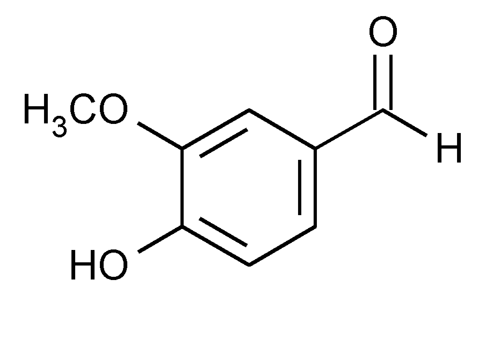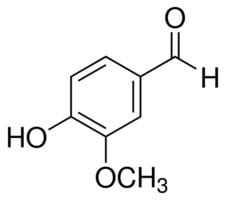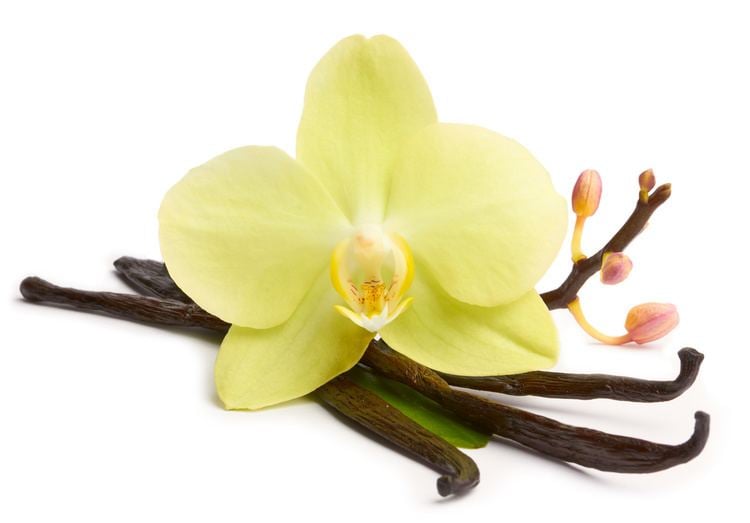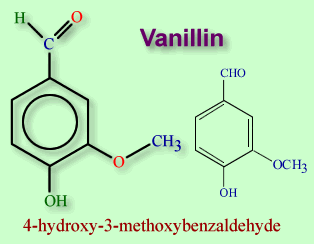3DMet B00167 Formula C8H8O3 Log P 1.208 | Appearance White crystals Molar mass 152.15 g/mol Acidity (pKa) 7.781 GHS hazard statements H302, H317, H319 | |
 | ||
Related compounds Melting point 81 to 83 °C; 178 to 181 °F; 354 to 356 K | ||
Vanillin is a phenolic aldehyde, which is an organic compound with the molecular formula C8H8O3. Its functional groups include aldehyde, hydroxyl, and ether. It is the primary component of the extract of the vanilla bean. Synthetic vanillin is now used more often than natural vanilla extract as a flavoring agent in foods, beverages, and pharmaceuticals.
Contents
- Ligno flava sustainable vanillin natural flavor concept video
- History
- Occurrence
- Natural production
- Biosynthesis
- Chemical synthesis
- Uses
- Manufacturing
- Adverse effects
- Ecology
- References

Vanillin and ethylvanillin are used by the food industry; ethylvanillin is more expensive, but has a stronger note. It differs from vanillin by having an ethoxy group (–O–CH2CH3) instead of a methoxy group (–O–CH3).

Natural "vanilla extract" is a mixture of several hundred different compounds in addition to vanillin. Artificial vanilla flavoring is often a solution of pure vanillin, usually of synthetic origin. Because of the scarcity and expense of natural vanilla extract, synthetic preparation of its predominant component has long been of interest. The first commercial synthesis of vanillin began with the more readily available natural compound eugenol. Today, artificial vanillin is made either from guaiacol or lignin.

Lignin-based artificial vanilla flavoring is alleged to have a richer flavor profile than oil-based flavoring; the difference is due to the presence of acetovanillone, a minor component in the lignin-derived product that is not found in vanillin synthesized from guaiacol.

Ligno flava sustainable vanillin natural flavor concept video
History

Vanilla was cultivated as a flavoring by pre-Columbian Mesoamerican people; at the time of their conquest by Hernán Cortés, the Aztecs used it as a flavoring for chocolate. Europeans became aware of both chocolate and vanilla around 1520.

Vanillin was first isolated as a relatively pure substance in 1858 by Nicolas-Theodore Gobley, who obtained it by evaporating a vanilla extract to dryness, and recrystallizing the resulting solids from hot water. In 1874, the German scientists Ferdinand Tiemann and Wilhelm Haarmann deduced its chemical structure, at the same time finding a synthesis for vanillin from coniferin, a glucoside of isoeugenol found in pine bark. Tiemann and Haarmann founded a company, Haarmann and Reimer (now part of Symrise) and started the first industrial production of vanillin using their process in Holzminden, Germany. In 1876, Karl Reimer synthesized vanillin (2) from guaiacol (1).
By the late 19th century, semisynthetic vanillin derived from the eugenol found in clove oil was commercially available.
Synthetic vanillin became significantly more available in the 1930s, when production from clove oil was supplanted by production from the lignin-containing waste produced by the sulfite pulping process for preparing wood pulp for the paper industry. By 1981, a single pulp and paper mill in Thorold, Ontario supplied 60% of the world market for synthetic vanillin. However, subsequent developments in the wood pulp industry have made its lignin wastes less attractive as a raw material for vanillin synthesis. While some vanillin is still made from lignin wastes, most synthetic vanillin is today synthesized in a two-step process from the petrochemical precursors guaiacol and glyoxylic acid.
Beginning in 2000, Rhodia began marketing biosynthetic vanillin prepared by the action of microorganisms on ferulic acid extracted from rice bran. At $700/kg, this product, sold under the trademarked name Rhovanil Natural, is not cost-competitive with petrochemical vanillin, which sells for around $15/kg. However, unlike vanillin synthesized from lignin or guaiacol, it can be labeled as a natural flavoring.
Occurrence
Vanillin is most prominent as the principal flavor and aroma compound in vanilla. Cured vanilla pods contain about 2% by dry weight vanillin; on cured pods of high quality, relatively pure vanillin may be visible as a white dust or "frost" on the exterior of the pod.
It is also found in Leptotes bicolor, a species of orchid native to Paraguay and southern Brazil, and the Chinese red pine.
At lower concentrations, vanillin contributes to the flavor and aroma profiles of foodstuffs as diverse as olive oil, butter, raspberry, and lychee fruits.
Aging in oak barrels imparts vanillin to some wines, vinegar, and spirits.
In other foods, heat treatment generates vanillin from other chemicals. In this way, vanillin contributes to the flavor and aroma of coffee, maple syrup, and whole-grain products including corn tortillas and oatmeal.
Natural production
Natural vanillin is extracted from the seed pods of Vanilla planifolia, a vining orchid native to Mexico, but now grown in tropical areas around the globe. Madagascar is presently the largest producer of natural vanillin.
As harvested, the green seed pods contain vanillin in the form of its β-D-glucoside; the green pods do not have the flavor or odor of vanilla.
After being harvested, their flavor is developed by a months-long curing process, the details of which vary among vanilla-producing regions, but in broad terms it proceeds as follows:
First, the seed pods are blanched in hot water, to arrest the processes of the living plant tissues. Then, for 1–2 weeks, the pods are alternately sunned and sweated: during the day, they are laid out in the sun, and each night, wrapped in cloth and packed in airtight boxes to sweat. During this process, the pods become dark brown, and enzymes in the pod release vanillin as the free molecule. Finally, the pods are dried and further aged for several months, during which time their flavors further develop. Several methods have been described for curing vanilla in days rather than months, although they have not been widely developed in the natural vanilla industry, with its focus on producing a premium product by established methods, rather than on innovations that might alter the product's flavor profile.
Biosynthesis
While the exact route of vanillin biosynthesis in V. planifolia is currently unknown, several pathways are proposed for its biosynthesis. Vanillin biosynthesis is generally agreed to be part of the phenylpropanoid pathway starting with L-phenylalanine, which is deaminated by phenylalanine ammonia lyase (PAL) to form t-cinnamic acid. The para position of the ring is then hydroxylated by the cytochrome P450 enzyme cinnamate 4-hydroxylase (C4H/P450) to create p-coumaric acid. Then, in the proposed ferulate pathway, 4-hydroxycinnamoyl-CoA ligase (4CL) attaches p-coumaric acid to coenzyme A (CoA) to create p-coumaroyl CoA. Hydroxycinnamoyl transferase (HCT) then converts p-coumaroyl CoA to 4-coumaroyl shikimate/quinate. This subsequently undergoes oxidation by the P450 enzyme coumaroyl ester 3’-hydroxylase (C3’H/P450) to give caffeoyl shikimate/quinate. HCT then exchanges the shikimate/quinate for CoA to create caffeoyl CoA, and 4CL removes CoA to afford caffeic acid. Caffeic acid then undergoes methylation by caffeic acid O-methyltransferase (COMT) to give ferulic acid. Finally, vanillin synthase hydratase/lyase (vp/VAN) catalyzes hydration of the double bond in ferulic acid followed by a retro-aldol elimination to afford vanillin. Vanillin can also be produced from vanilla glycoside with the additional final step of deglycosylation. In the past p-hydroxybenzaldehyde was speculated to be a precursor for vanillin biosynthesis. However, recently it was demonstrated by radiolabelled precursor studies that p-hydroxybenzaldehyde do not synthesis vanillin or vanillin glucoside in the vanilla orchids.
Chemical synthesis
The demand for vanilla flavoring has long exceeded the supply of vanilla beans. As of 2001, the annual demand for vanillin was 12,000 tons, but only 1,800 tons of natural vanillin were produced. The remainder was produced by chemical synthesis. Vanillin was first synthesized from eugenol (found in oil of clove) in 1874–75, less than 20 years after it was first identified and isolated. Vanillin was commercially produced from eugenol until the 1920s. Later it was synthesized from lignin-containing "brown liquor", a byproduct of the sulfite process for making wood pulp. Counterintuitively, though it uses waste materials, the lignin process is no longer popular because of environmental concerns, and today most vanillin is produced from the petrochemical raw material guaiacol. Several routes exist for synthesizing vanillin from guaiacol.
At present, the most significant of these is the two-step process practiced by Rhodia since the 1970s, in which guaiacol (1) reacts with glyoxylic acid by electrophilic aromatic substitution. The resulting vanillylmandelic acid (2) is then converted via 4-Hydroxy-3-methoxyphenylglyoxylic acid (3) to vanillin (4) by oxidative decarboxylation.
Uses
The largest use of vanillin is as a flavoring, usually in sweet foods. The ice cream and chocolate industries together comprise 75% of the market for vanillin as a flavoring, with smaller amounts being used in confections and baked goods.
Vanillin is also used in the fragrance industry, in perfumes, and to mask unpleasant odors or tastes in medicines, livestock fodder, and cleaning products. It is also used in the flavor industry, as a very important key note for many different flavors, especially creamy profiles such as cream soda.
Additionally, vanillin can be used as a general-purpose stain for developing thin layer chromatography plates to aid in visualizing components of a reaction mixture. This stain yields a range of colors for these different components.
Vanillin–HCl staining can be used to visualize the localisation of tannins in cells.
Manufacturing
Vanillin has been used as a chemical intermediate in the production of pharmaceuticals, cosmetics, and other fine chemicals. In 1970, more than half the world's vanillin production was used in the synthesis of other chemicals. As of 2016, vanillin uses have expanded to include perfumes, flavoring and aromatic masking in medicines, various consumer and cleaning products, and livestock foods.
Adverse effects
Vanillin can trigger allergic reactions, as well as migraine headaches in a small fraction of the people who experience migraines.
Ecology
Scolytus multistriatus, one of the vectors of the Dutch elm disease, uses vanillin as a signal to find a host tree during oviposition.
